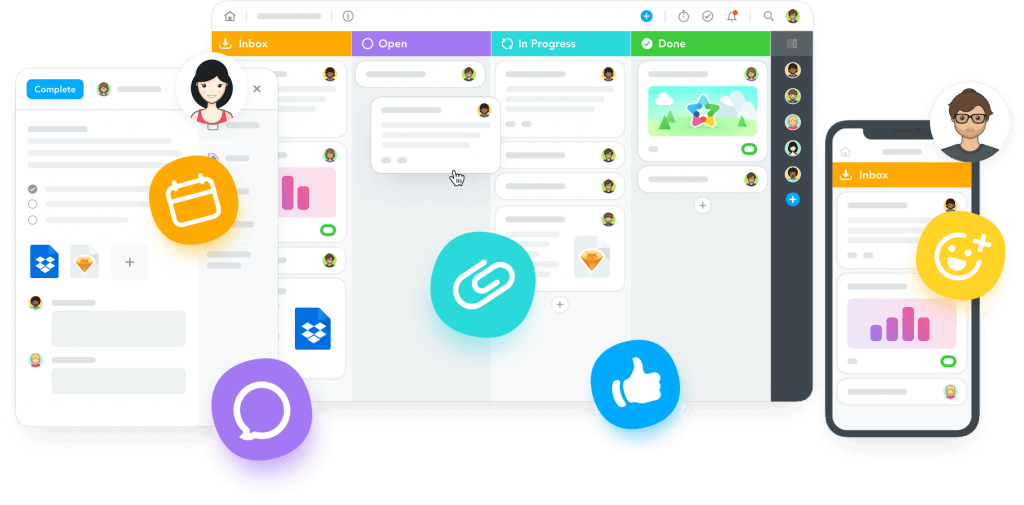Home

5 Tips for Choosing the Perfect Task Management App
- Details
- By:
- Category: Articles
- Hits: 1485
Mastering Time: The Evolution of Task Management in Mobile Apps Development
In the ever-evolving landscape of mobile apps development, task and time management applications have emerged as critical tools for productivity in both personal and professional spheres. With the global productivity management software market projected to reach $102.98 billion by 2027, according to Grand View Research, the demand for efficient task management solutions is skyrocketing. This article explores the key considerations in choosing the right task management app and the trends shaping this dynamic sector of mobile apps development.
Defining the Perfect Fit: Requirements Analysis
Before diving into the vast ocean of task management apps, it's crucial to define specific requirements. This step is fundamental in mobile apps development, ensuring that the final product aligns perfectly with user needs.
Key Questions to Consider:
- Is ease of task addition a priority?
- Do you need integration with other productivity tools?
- Are cross-platform capabilities essential?
Industry Insight: According to a survey by Capterra, 58% of professionals use task management software daily, highlighting the importance of choosing the right tool.
User Experience: The Cornerstone of Adoption
In the realm of mobile apps development, user experience (UX) can make or break an application's success. For task management apps, intuitive design is paramount.
Case Study: Todoist Todoist's clean, minimalist interface has contributed to its 25 million+ user base. The app's "Quick Add" feature allows users to input tasks in natural language, demonstrating how smart UX design can significantly enhance productivity.
Multi-Platform Compatibility: The Mobile Imperative
With work increasingly happening on-the-go, cross-platform functionality is no longer a luxury—it's a necessity in mobile apps development.
Statistics Speak: A study by RescueTime found that people check their phones 58 times a day on average, with 30 of these checks occurring during work hours.
Leading Cross-Platform Apps:
- Asana: Available on web, iOS, and Android
- Trello: Accessible via web, mobile, and even wearables
- Microsoft To Do: Seamlessly syncs across Windows, mobile, and web platforms
Integration Capabilities: The Power of Connectivity
In the ecosystem of mobile apps development, integration capabilities can significantly enhance an app's utility.
Popular Integrations:
- Calendar apps (Google Calendar, Apple Calendar)
- Email clients (Gmail, Outlook)
- Communication tools (Slack, Microsoft Teams)
Example: Asana's integration with over 100 other apps allows users to create tasks directly from emails or Slack messages, streamlining workflow and reducing context switching.
Communication and Reminders: Keeping Users on Track
Effective communication features and smart reminder systems are crucial components in task management apps.
Key Features to Look For:
- Customizable notifications
- Team collaboration tools
- Location-based reminders
Industry Trend: AI-powered reminders are gaining traction in mobile apps development. Apps like Any.do use machine learning to suggest optimal times for task completion based on user behavior.
The Future of Task Management in Mobile Apps Development
As we look towards the future, several trends are shaping the landscape of task management apps:
- AI and Machine Learning Integration AI is being leveraged to provide smart task prioritization and workload balancing. For instance, Reclaim.ai uses AI to automatically schedule tasks in users' calendars.
- Augmented Reality (AR) in Task Visualization Companies like Microsoft are exploring AR for task management, allowing users to visualize their tasks in 3D space.
- Voice-Activated Task Management With the rise of voice assistants, voice-activated task creation and management are becoming increasingly popular. Google Tasks' integration with Google Assistant exemplifies this trend.
- Blockchain for Secure Task Tracking Some startups are exploring blockchain technology to create tamper-proof task logs, particularly useful for project management in industries requiring high accountability.
Conclusion: The Task Management Revolution
As the lines between personal and professional life continue to blur, effective task management has become more critical than ever. In the realm of mobile apps development, task management applications stand at the forefront of productivity innovation.
For developers and businesses alike, understanding the nuances of user needs, prioritizing seamless UX, ensuring cross-platform compatibility, and leveraging cutting-edge technologies like AI and AR will be key to creating successful task management solutions.
As we move forward, the most successful apps in this space will be those that not only help users manage their tasks but do so in a way that seamlessly integrates with their digital lives. In the competitive world of mobile apps development, the ultimate goal is clear: to turn the chaos of daily tasks into a symphony of productivity, all at the tap of a screen.

User experience (UX) in app development in the new era
- Details
- By:
- Category: Articles
- Hits: 1626
The UX Revolution: Transforming Mobile Apps Development
In the ever-evolving landscape of mobile apps development, User Experience (UX) has emerged as a critical differentiator. With over 3.8 million apps on Google Play and 1.96 million on the Apple App Store as of 2023, according to Statista, creating an intuitive and engaging user experience is no longer optional—it's imperative for success.
From UI to UX: The Paradigm Shift
While User Interface (UI) design once dominated discussions in mobile apps development, the focus has broadened to encompass the entire User Experience (UX). This shift reflects a deeper understanding of user needs and behaviors in the digital age.
Case Study: Duolingo Language learning app Duolingo exemplifies the power of UX in mobile apps development. Its gamified approach and intuitive design have contributed to its 500 million downloads and a $6.5 billion valuation in 2021.
The Survey Conundrum: Benefits and Limitations
Surveys remain a popular tool in UX research, offering a straightforward method to collect user feedback. However, their effectiveness hinges on careful design and implementation.
Key Considerations for Survey Design:
- Avoid leading questions
- Use a diverse, representative sample
- Keep surveys concise to prevent fatigue
Industry Insight: According to a study by the Nielsen Norman Group, survey response rates for mobile apps average around 13%, highlighting the importance of incentivizing participation.
Beyond Surveys: Advanced UX Testing Methodologies
As mobile apps development becomes increasingly sophisticated, UX researchers are employing more advanced techniques to gain deeper insights:
- Eye Tracking: Seeing Through Users' Eyes Eye tracking technology offers unparalleled insights into user attention and behavior. Example: Spotify used eye tracking to optimize its mobile interface, resulting in a 30% increase in user engagement with recommended playlists.
- Mouse Tracking: The Digital Body Language While less precise than eye tracking, mouse tracking provides valuable data on user interaction patterns. Case Study: LinkedIn's mobile app team used mouse tracking to identify pain points in their job application process, leading to a 20% increase in completed applications.
- A/B Testing: The Power of Comparison A/B testing allows developers to compare different versions of app features or designs. Success Story: Instagram's switch to a vertically scrolling feed for Stories, based on A/B testing results, led to a 7% increase in user engagement.
Comprehensive UX Testing: Beyond Single Metrics
Effective UX testing in mobile apps development often involves a multi-faceted approach:
- Task Performance Analysis Users are asked to complete specific tasks within the app while being observed. Metrics to Track:
- Time to complete task
- Error rate
- Success rate
- Emotional Response Tracking Tools like facial recognition software can gauge users' emotional responses to different app features. Industry Application: Netflix uses emotional response data to refine its content recommendation algorithms, contributing to its 231 million global subscribers.
- Accessibility Testing Ensuring apps are usable by people with disabilities is crucial for inclusive design. Legal Consideration: The number of digital accessibility lawsuits in the U.S. increased by 14% in 2022, underscoring the importance of accessibility in mobile apps development.
The Future of UX Testing in Mobile Apps Development
As we look towards the future, several trends are shaping UX testing methodologies:
- AI-Powered UX Analysis Machine learning algorithms are being employed to analyze vast amounts of user data and predict UX pain points.
- Virtual and Augmented Reality Testing As VR and AR applications grow, new UX testing methodologies are emerging to address these immersive environments.
- Biometric UX Testing Advanced biometric tools, including EEG headsets and galvanic skin response sensors, are providing deeper insights into user experiences.
Conclusion: UX as the Cornerstone of Successful Mobile Apps Development
In today's fast-paced digital ecosystem, where users decide within seconds whether to engage with an app, UX has become the linchpin of successful mobile apps development. The difference between an app's success and failure often lies not just in its functionality, but in how intuitively and enjoyably users can access that functionality.
For developers and businesses alike, investing in comprehensive UX testing and iterative design processes is no longer a luxury—it's a necessity. By leveraging a combination of traditional surveys, advanced tracking technologies, and emerging AI-powered analytics, mobile app developers can create experiences that not only meet user needs but exceed their expectations.
As we move forward, the most successful apps will be those that seamlessly blend functionality with user-centric design, creating experiences that users not only use, but love. In the competitive world of mobile apps development, UX isn't just about usability—it's about creating digital experiences that resonate on a human level.

How to Solve Problems with Innovative Apps
- Details
- By:
- Category: Articles
- Hits: 1366
The Problem-Solving Paradigm: How Mobile Apps Development is Reshaping Our World
In an era where challenges abound, from minor inconveniences to major societal issues, mobile apps development has emerged as a powerful tool for problem-solving. With the global mobile app market projected to reach $935 billion by 2023, according to Statista, developers are at the forefront of creating innovative solutions that address a wide spectrum of human needs and challenges.
The App Developer: Modern-Day Problem Solver
Mobile apps development has evolved into a crucial problem-solving discipline. As smartphone usage continues to soar—with over 6.8 billion smartphone users worldwide in 2023, as reported by Statista—app developers are uniquely positioned to create solutions that can reach billions of people instantly.
Case Study: Calm The meditation app Calm, which addresses the growing issue of stress and anxiety, has over 100 million downloads and was valued at $2 billion in 2020, demonstrating the immense potential of problem-solving apps.
Customized Applications: Tailored Solutions for Every Challenge
In the realm of mobile apps development, customization is key. Industries across the board are investing in bespoke applications to streamline processes, enhance employee engagement, and reach new markets.
Industry Example: Healthcare The healthcare sector has seen a surge in custom app development. Apps like Medisafe, which helps patients manage their medications, have over 7 million users and have been shown to improve medication adherence by up to 20%.
Why Mobile Apps Excel at Problem-Solving
Mobile apps offer unique advantages in addressing various challenges:
- Accessibility: With smartphones always at hand, solutions are literally at users' fingertips.
- Real-time Updates: Apps can provide instant information and solutions.
- Personalization: AI and machine learning enable apps to offer tailored solutions to individual users.
- Integration: Apps can seamlessly integrate with other systems and devices, offering comprehensive solutions.
Example: Uber Uber's success in solving transportation challenges stems from its ability to leverage these advantages. The app processes over 14 million rides daily, demonstrating the scale at which mobile apps can address global issues.
Strategies for Effective Problem-Solving in Mobile Apps Development
- Deep Problem Analysis Understanding the root cause of a problem is crucial. Successful app developers spend significant time researching and analyzing issues before coding begins. Tip: Use techniques like the "5 Whys" to dig deeper into problem analysis.
- Competitor Research Analyzing existing solutions helps identify gaps and opportunities for innovation. Case Study: Duolingo Before developing their language learning app, Duolingo's team extensively studied existing solutions, leading to their gamified approach that now engages over 500 million users.
- User-Centric Design Effective problem-solving apps prioritize user experience and interface design. Industry Insight: According to a study by Forrester, every dollar invested in UX brings 100 dollars in return, an ROI of 9,900%.
- Iterative Development The most successful problem-solving apps evolve through continuous feedback and improvement. Example: Instagram Instagram's evolution from a simple photo-sharing app to a comprehensive social media platform with features like Stories and Reels demonstrates the power of iterative development in addressing changing user needs.
The Future of Problem-Solving in Mobile Apps Development
As we look towards the future, several trends are shaping the landscape of problem-solving apps:
- AI and Machine Learning Integration AI-powered apps like Replika, which provides conversational companionship, are addressing complex emotional and psychological needs.
- Internet of Things (IoT) Connectivity Smart home apps that control various devices are solving issues of energy efficiency and home management.
- Augmented Reality (AR) Solutions Apps like IKEA Place use AR to solve furniture shopping challenges, allowing users to visualize products in their homes before purchase.
- Blockchain for Trust and Security Apps utilizing blockchain technology are addressing issues of data security and transparency across various sectors.
Conclusion: The Mobile App as a Universal Problem Solver
As we continue to face new challenges in our personal and professional lives, mobile apps development stands at the forefront of problem-solving innovation. From addressing global issues like climate change with apps that track carbon footprints, to solving everyday annoyances like finding parking spaces in busy cities, the potential for mobile apps to improve our lives is boundless.
For developers, the key to success lies in deeply understanding problems, leveraging cutting-edge technologies, and continuously iterating based on user feedback. As the line between the digital and physical worlds continues to blur, the role of mobile apps in problem-solving will only grow more significant.
In this new era of digital solutions, the most successful developers will be those who can identify problems before they become apparent, anticipate user needs, and create intuitive, effective apps that seamlessly integrate into our daily lives. The future of problem-solving is mobile, and the possibilities are as limitless as human ingenuity itself.

Artificial Intelligence in App Development
- Details
- By:
- Category: Articles
- Hits: 1291
AI-Driven Business Intelligence: Revolutionizing Mobile Apps Development
In the rapidly evolving landscape of mobile apps development, Artificial Intelligence (AI) has emerged as a game-changing force, particularly in the realm of Business Intelligence (BI). As smartphones become increasingly powerful, capable of handling complex machine learning systems, the integration of AI and BI in mobile applications is opening new frontiers for businesses to analyze and leverage data without the need for extensive IT support.
The Rise of AI in Mobile BI
The global mobile BI market is projected to reach $20.7 billion by 2027, growing at a CAGR of 21.6% from 2020 to 2027, according to Allied Market Research. This explosive growth is fueled by the increasing demand for data-driven decision-making on-the-go.
What is Mobile Business Intelligence?
Mobile BI refers to the ability of smartphone applications to learn, adapt, and analyze user behavior, providing intelligent insights and enhancing user experience. For instance, popular email apps like Gmail use AI to categorize emails and predict responses, significantly improving productivity for millions of users worldwide.
The BI Roadmap in Mobile Apps Development
The integration of BI in mobile apps development focuses on creating tools that store, retrieve, and analyze data to aid corporate decision-making. Companies like Tableau and Power BI have developed mobile versions of their analytics platforms, allowing business leaders to access critical insights anytime, anywhere.
Key Advantages of AI-Driven BI in Mobile Apps
- Real-Time Data Collection AI-powered mobile apps can gather and process data in real-time. For example, retail giant Walmart uses mobile BI to track inventory levels across stores, enabling immediate restocking decisions.
- Enhanced Decision Making With instant access to analyzed data, business leaders can make informed decisions quickly. Starbucks' mobile app, which uses AI to predict customer orders, has contributed to a 7% increase in store visits.
- Competitive Edge Real-time insights allow businesses to be more responsive to market changes. Uber's dynamic pricing model, powered by mobile BI, has helped the company maintain its market leadership in ride-sharing.
- Increased Productivity By automating data analysis, mobile BI apps save time and resources. Salesforce's AI-powered Einstein Analytics mobile app has helped sales teams increase their lead conversion rates by up to 30%.
- Improved Customer Satisfaction AI-driven personalization in mobile apps enhances customer experience. Netflix's mobile app, which uses AI to recommend content, reports that 75% of viewer activity is driven by personalized suggestions.
- Revenue Growth The cumulative effect of these advantages often leads to increased profits. Amazon's mobile app, which uses AI for personalized product recommendations, contributes to 35% of the company's total revenue.
Challenges in Implementing Mobile BI
Despite its potential, the integration of AI-driven BI in mobile apps development faces several challenges:
- Network Reliability Inconsistent internet connectivity can hinder real-time data processing. To address this, companies like Google are developing offline-capable ML models for Android apps.
- Complexity and Scale Processing large datasets on mobile devices can be challenging. Apple's Core ML framework aims to optimize on-device machine learning, reducing the computational load.
- Hardware Limitations High-performance AI often requires powerful hardware, which can be costly. Qualcomm's AI Engine is working to bring advanced AI capabilities to mid-range smartphones.
Overcoming Mobile BI Challenges
To address these challenges, the mobile apps development industry is exploring several solutions:
- Edge Computing By processing data closer to the source, edge computing reduces reliance on network connectivity. For instance, Google's Edge TPU allows for on-device machine learning inference.
- Simplified BI Tools Companies are developing more user-friendly mobile BI tools. Looker's mobile app, for example, offers a simplified interface for accessing complex data visualizations.
- Cloud-Mobile Hybrid Solutions Hybrid approaches leverage both cloud and mobile resources. Microsoft's Azure Mobile Apps allows for seamless integration between cloud-based AI services and mobile applications.
The Future of AI-Driven Mobile BI
As we look towards the future of mobile apps development, several trends are shaping the landscape of AI-driven mobile BI:
- 5G Integration: The rollout of 5G networks promises to address connectivity issues, enabling more complex, real-time AI applications on mobile devices.
- Augmented Reality (AR) in BI: Companies like Apple are exploring AR-based data visualization in mobile BI apps, offering immersive ways to interact with business data.
- Voice-Activated BI: As voice recognition technology improves, we can expect to see more voice-activated BI features in mobile apps, similar to how Siri or Google Assistant operate.
Conclusion: The Mobile BI Imperative
As the business world becomes increasingly mobile-first, the integration of AI-driven BI in mobile apps development is no longer a luxury—it's a necessity for companies looking to stay competitive. By leveraging the power of AI and machine learning on mobile platforms, businesses can unlock new levels of efficiency, customer satisfaction, and profitability.
The challenges in implementing mobile BI are significant, but so are the potential rewards. As technology continues to evolve, we can expect to see even more innovative solutions emerging in the field of mobile apps development, further blurring the lines between artificial intelligence, business intelligence, and mobile technology.
In this new era of data-driven decision making, the most successful businesses will be those that effectively harness the power of AI-driven mobile BI, turning the smartphones in our pockets into powerful tools for business transformation.

 ES
ES  KO
KO  NL
NL  CS
CS  HR
HR  PT
PT  RO
RO  SV
SV  IT
IT  EL
EL  DE
DE  FR
FR  PL
PL  EN
EN